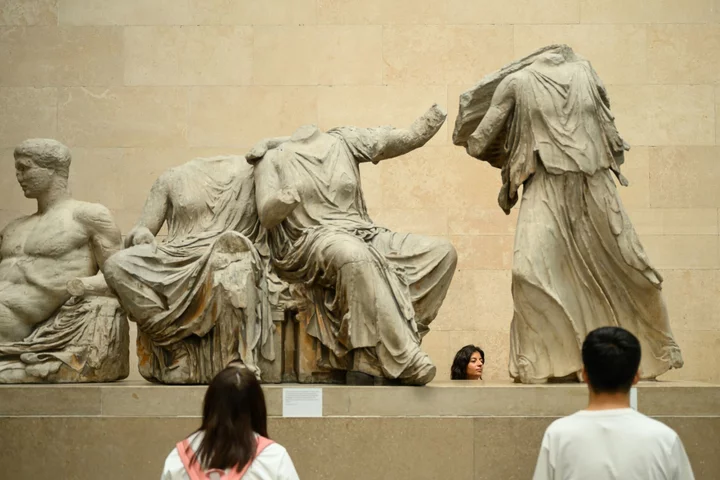UK Prime Minister Rishi Sunak’s last-minute cancellation of a meeting with his Greek counterpart Kyriakos Mitsotakis in London has brought renewed attention to the centuries-old dispute over the ownership of the Parthenon Sculptures, sometimes referred to as the Elgin Marbles. Both countries claim ownership of the pieces housed in London’s British Museum, but in recent years the two sides had appeared close to a deal in which they would be loaned to Athens in exchange for other artifacts. Here’s an exploration of the history of the dispute and why it’s continued for so long.
What are the Parthenon Marbles?
The Parthenon Marbles are a collection of sculptures and friezes that were created by ancient Greek sculptor Phidias in the 5th Century B.C. to adorn the Parthenon and other parts of the Athens Acropolis. They are widely considered to be among the world’s finest examples of classical sculpture. They were removed from the Acropolis by agents of the 7th Earl of Elgin who had been the British ambassador to Constantinople -- then the capital of the Ottoman Empire -- at the start of the 19th century, when Greece was controlled by the Ottomans.
Why are the Parthenon Marbles so special?
On top of their exceptional beauty and craftsmanship, they are a vital part of Greek cultural heritage. They have symbolic importance as a vestige of the ancient city-state of Athens, which after the Enlightenment came to be considered the birthplace of Western civilization.
When and why were the marbles removed from the Acropolis?
Elgin’s agents removed the marbles from the Acropolis in the first years of the 19th century, and later sold them to the British Museum, where they have been on display since 1817. Elgin, who was both a diplomat and an art collector, said he removed them out of concern that the Ottoman authorities weren’t looking after them properly. He was later accused of stealing the stones, and of vandalism and pillaging. Lord Byron wrote a poem accusing him of defacing the Parthenon.
Why are they so controversial?
They are controversial because the British and Greek governments disagree on who owns the marbles and whether they should stay in London. Since Greece gained independence from the Ottomans in 1832, it has repeatedly asked for them back. As minister of culture, Greek actress Melina Mercouri was responsible for publicizing the cause internationally in the 1980s. A few months after Mercouri visited London in 1983, the Greek government made a formal request for the marbles’ return, which the UK government formally rejected the next year.
Why won’t Britain return the Parthenon Marbles?
The trustees of the British museum say that they legally own the marbles and that they cannot be permanently returned to Greece because of the museum’s “legal and moral responsibility to preserve and maintain all the collections in their care and to make them accessible to world audiences.” They are considered to be the most important items in the British Museum, which attracts more than 4 million visitors a year.
The British Museum Act 1963 also forbids the museum from disposing of any of its collection, meaning that the UK government would have to change the law to send them back. The law, which neither Sunak nor the leader of the opposition say they have plans to change, may also complicate a loan agreement.
The Parthenon Project, a campaign group funded by the family of Greek industrialist John Lefas, claims to have found a way to move the marbles to Athens without changing the law. Under the group’s proposals, the marbles would be reunified at the Acropolis Museum in exchange for rare Greek artworks being sent to the British Museum and both sides would “agree to disagree” over the ownership of the marbles. In 2022 British Museum Chairman George Osborne said there was a “deal to be done,” and he reportedly held meetings with the Greek government this year. Labour opposition leader Keir Starmer said he would not stand in the way of a temporary loan if the British Museum and Athens agreed. In recent days the ruling Conservative Party has hardened its position to say it opposes any return of the marbles to Greece.
What’s the position of the Greek government?
The Greek government’s position is that the marbles were stolen by Elgin and that they should be displayed in the Acropolis Museum, which houses some of the original Parthenon sculptures as well as plaster copies of those in the British Museum. “If I told you that you would cut the Mona Lisa in half, and you will have half of it at the Louvre and half of it at the British Museum, do you think your viewers would appreciate the beauty of the painting?” Mitsotakis asked in a BBC interview before his meeting with Sunak; comments that senior Conservative Party sources told Bloomberg were the reason for its cancellation. Greece ruled out taking legal action against the UK in 2015, saying it would pursue a “diplomatic and political” approach to securing their return. In 2013 it proposed a mediation process with the help of UNESCO that would include the British Museum and UK government. Both of those parties rejected the idea in 2015.
Did the Earl of Elgin legally take the marbles?
The British Museum says Elgin took and transported the marbles to England “with the full knowledge and permission of the legal authorities of the day in both Athens and London,” and cites an 1816 UK parliament hearing which cleared him of stealing them. The Greek government says that their removal was illegal, and disputes the authority of those Ottoman-era permissions.
Who should have the Parthenon Marbles?
Most British people think the marbles belong in Greece, not Britain, according to a YouGov poll conducted in 2021 by the Parthenon Project. It found that 64% of all British people say they belong there rather than London. Among Conservative Party voters, 28% think they belong in Britain. Yet many prominent politicians from that party, including former Prime Minister Liz Truss, have said they oppose returning the marbles.
Author: Conrad Quilty-Harper









